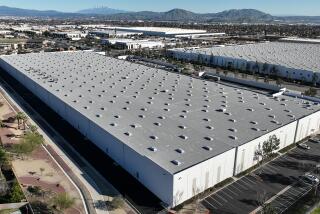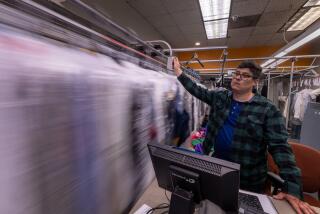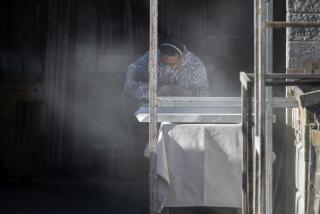Citing Health Hazards, State Halts Jewelry Making in an L.A. Building
The discovery of hazardous air pollution has prompted state officials to order a halt to jewelry manufacturing in a building in the core of the downtown Los Angeles jewelry district, the nation’s second-largest.
While the attorney general’s order targets unlawful levels of potentially cancer-causing heavy metals in one building, the downtown jewelry district comprises more than 30 buildings employing thousands of workers in similar enterprises.
Business owners say the jobs of 15,000 jewelry workers could be in jeopardy; state environmental officials contend that it is the health of those very workers and possibly thousands of others that may be endangered.
Officials of the California Environmental Protection Agency fear that workers, customers and neighbors throughout the jewelry district may be exposed to dangerous pollutants. “If the same activity is going on, with the same characteristics and same factors present, it’s not out of the question there are the same hazards,” said Helen Pelzman, deputy director of the EPA’s Department of Toxic Substance Control.
Owners of the Park Central Building at 412 W. 6th St. who were ordered to stop jewelry making say the action could prompt them to vacate the premises. Civic leaders also say an environmental crackdown could turn the now-bustling area into a ghost town.
“The fear is it will shut down an industry, and 35 to 40 buildings will be seen as undesirable,” said Carol Schatz, president of the Downtown Center Business Improvement District.
The attorney general has been asked by Cal/EPA to sue the owners of the Park Central Building and two jewelry manufacturers based there.
The suit has yet to be filed, but the attorney general, in a June 19 letter, directed the building owners to halt jewelry manufacturing operations until pollution control equipment can be installed.
Tests by the state toxic substance agency found hazardous levels of cadmium, chromium, lead, copper, nickel, silver and zinc in air and dust samples taken throughout the building, including areas where workers ate their meals. The hazardous wastes were produced by furnaces and by grinding and buffing operations in the building, according to the test results.
Ernest Wish, the lawyer for the building’s owners, Casa LLC, said the company is installing pollution control equipment and wants to cooperate with environmental officials. Wish said, however, that his client wants to allow jewelry manufacturing to continue while the protective measures are being taken.
“If those activities stop, those tenants are going to go out of business,” Wish said. About 120 of the building’s roughly 150 tenants are involved in the manufacture of jewelry, Wish said.
State officials insist that the manufacturing must stop until pollution controls are in place. “You can’t agree to let people continue to violate the law, particularly concerning hazardous wastes,” said Lisa Brown, an enforcement lawyer for Cal/EPA.
The attorney general’s action came after manufacturers and building owners had been meeting with city officials for the better part of a year to craft an environmental compliance plan that would protect the business life of the district and the more than $11 million in annual tax revenue it channels to the city.
Crackdown Spreads Panic Along 6th Street
Now, the action of state officials against the 6th Street property has many people in the district panicked that the negotiations with the city were for naught.
“We are worried,” said Mike Youssefian, executive director of Los Angeles United Investment Co., which owns the massive St. Vincent Jewelry Center. “We think this will have a domino effect on all the buildings.”
Jeweler Peter Boyadjian said it seems unlikely that the crackdown would end with one building. “They’re going to start saying, ‘Let’s take a look at the other buildings,’ ” he said. “I will guarantee [conditions] are the same or even worse.”
If a similar crackdown were to hit districtwide, workers “will be just going home. There will be no manufacturing, no jobs, no sales tax to the city,” Youssefian said. “That would be a disaster.”
Youssefian’s building alone is home to 450 businesses and more than 3,000 workers. While the building owners have spent “millions” on water filtration and ventilation systems, not all the buildings are equally outfitted, he said.
Only about a fourth of the district’s businesses are believed to manufacture there, but their well-being is inextricably linked to that of the wholesalers and retailers they supply. Those merchants, in turn, pass the goods to markets around the globe, jewelers said.
“It all goes in a circle,” said Thomas Thomassian, manager of a manufacturer of wedding bands on Hill Street. “If they slowly get more and more aggressive, that’s understandable, but not all of a sudden. Closing down a building is just unnecessary.”
The district has long been obsessed with security. The immigrant networks that built it have closely guarded their business practices.
Secretive Ways of District Don’t Help
Mexican craftsmen were joined in the 1970s by Armenian jewelers fleeing civil war in Lebanon. Others followed from Iran, joined by Russians when the Soviet Union fractured. Ethnic Chinese manufacturers and wholesalers from Vietnam and Cambodia also came, as did Israeli diamond dealers.
Leon Chant Haytayan, vice president of the Armenian Jewelers Assn., said most of the small manufacturers in the district employ their own family members and would not want to place them in harm’s way.
But many lack the proper education on environmental safety issues, he said.
Both landlords and chemical suppliers must do their part to educate manufacturers, he said.
“We’re all concerned, and we’re all trying to see what it is we can do to make things right and safe so the city is satisfied and the state is satisfied and people can go on with their lives,” Haytayan said.
“You don’t want to work under pressure and fear that you’re going to be shut down.
The secretive atmosphere of the district and Old World ways haven’t always helped it, some younger-generation jewelers say.
The industry has had its share of tax and immigration violations, and not all manufacturers take necessary environmental precautions, said Boyadjian, a second-generation Armenian jeweler who is pushing to introduce Internet technology to the industry.
Furthermore, not all building owners are equally conscientious, Boyadjian said.
If one building manager pressures tenants to comply with the letter of environmental law, others may lure them with the promise of a more laissez faire approach, he said.
At the very least, the state’s crackdown could compel the less aggressive building managers to take a more active role in monitoring the compliance of their own tenants, Boyadjian said.
“It’s not going to happen unless someone gets hit hard,” he said. “Unfortunately, I think it has to be done that way. . . . The health hazards and repercussions are immense.”
More to Read
Sign up for Essential California
The most important California stories and recommendations in your inbox every morning.
You may occasionally receive promotional content from the Los Angeles Times.










